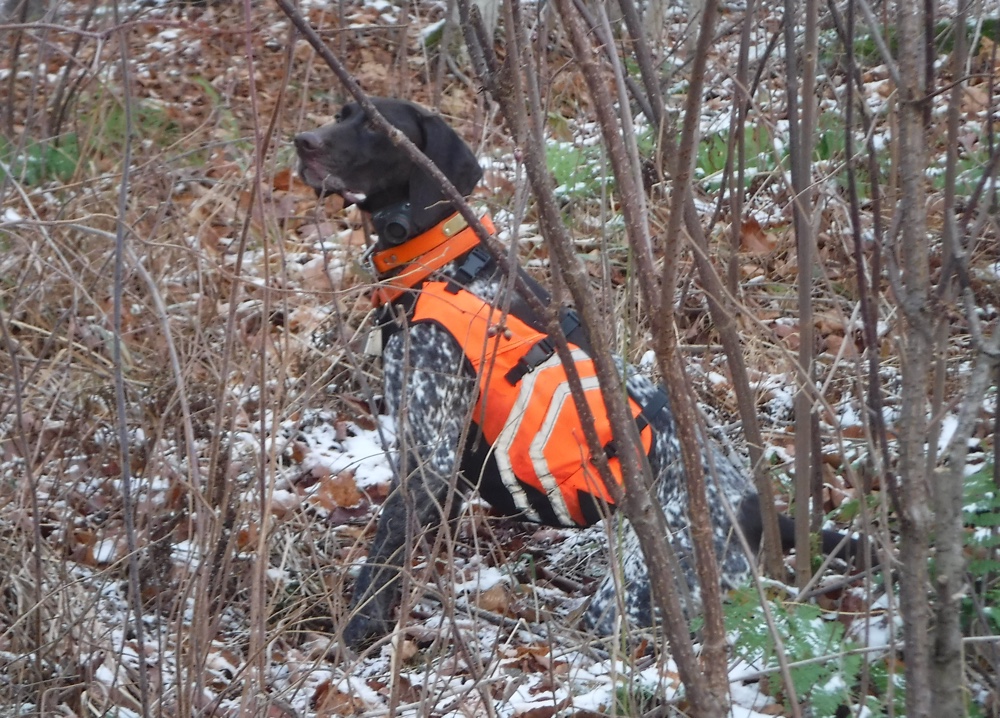
By the Numbers
Please keep in mind that this analysis is of the statistics to this point in the season - it does not include any hunting that I might do from here until December 31. The numbers have been compiled with clients of all ages (ranging from 28 to 79 years old) and experience levels in grouse hunting. For some, their first experience hunting the Gray Ghost was with me this year, while other clients already had an impressive resume of grouse hunting. Shooting abilities and physical limitations also played a part in these numbers. As you probably know by now, those that can walk farther for longer will probably see more grouse than those walking the roads ... especially after the birds have gotten some pressure along the edges.
Season Totals
Our NH coverts got a lot more attention this season than our Vermont areas (147.5 hours to 24.5), as would be expected, but the bird finding seemed to be better in the granite state than Vermont. A major reason might be that most of our better woodcock coverts are located in NH, which can skew the numbers, particularly in October.
We moved a total of 568 birds in 32 days of hunting. Of those, 340 were grouse, making the remaining 228 woodcock. That averages out to 10.625 grouse moved per day, and 7.125 woodcock seen per day. We generally hope to move about 20 birds a day, so we might've been a bit lower in our average this year, but it is, after all ... hunting.
Our best day of encountering grouse this year was 21 moved. This happened twice, on October 11 and 15. Our lowest total was a modest 2 encountered on October 5, when my clients and I worked a trail edge one afternoon (physical limitations). On the woodcock, we had quite a few great days, but the best day was our first out there. On October 1, we moved 19 woodcock, but there were several days in the upper teens throughout the season as well.
Three times we encountered 30 birds total between grouse and woodcock. Those exceptional days were on October 4, 10 and 15. We wish we had more, but that's how grouse hunting is sometimes.
Grouse & Woodcock Hunting by the Week
Week 1 (10/1 - 7): 117 birds moved (20% of the season total). 45 grouse, 72 woodcock. Took 1 grouse, 10 woodcock.
Week 2 (10/8 - 14): 128 birds moved (22%). 79 grouse, 49 woodcock. Took 6 woodcock.
Week 3 (10/15 - 21): 107 birds moved (19%). 71 grouse, 36 woodcock. Took 4 grouse, 3 woodcock.
Week 4 (10/22 - 28): 114 birds moved (20%). 61 grouse, 53 woodcock. Took 3 grouse, 7 woodcock.
Week 5 (10/29 - 11/4): 65 birds moved (11%). 49 grouse, 16 woodcock. Took 2 grouse, 1 woodcock.
Week 6 (11/5 - 7): 47 birds moved (8%). 34 grouse, 13 woodcock. Took 3 grouse, 2 woodcock.
Reading in to the numbers, it's apparent that the first two weeks of the season can be pretty good, especially if you like to shoot woodcock. They hold better for the dogs, and even with the screen of thick foliage they can present obtainable targets. The grouse shooting is tough the first two weeks of the season due to the foliage, but it gets better as we get in to late October and early November. Reflected in the numbers those first two weeks of the season are birds that we hear flush but not necessarily get a shot on. As the foliage drops, we are getting better visibility on the birds, offering at least a semblance of a shot.
Woodcock numbers are highest through most of October, and this year played out like most others in regards to the migration. Birds were moving out at the very end of October and early November as we would expect, and I'm sure the numbers also reflect seasonal hunting losses as well. Our best week of moving woodcock was Week 1, then a steady drop the next two weeks until a bump up in Week 4 with the arrival of fresh migrants from the north. The weather remained temperate this year, and our coldest days have been in the last week. The woodcock should all be gone next week, one would imagine.
The Performance of the Dogs
Rosie (3 yrs): 2 grouse and 11 woodcock taken
Bode (6 yrs): 3 grouse, 7 woodcock taken
Monty (9 yrs): 2 grouse, 2 woodcock taken
Rosie and Bode got the bulk of the work this year, in an attempt to take pressure off Monty. When Monty came up lame for a couple of weeks, Bode and Rosie were running nearly every day. This surely helped Rosie develop in to a solid worker and she had some great sessions out there. Bode also was very good this year and his patterning is excellent. Monty resumed his bird finding in the last two days and had more great moments, pointing four grouse, one of which was taken. Now, they get to rest a little ...
The remaining 6 grouse and 9 woodcock were either taken over clients's dogs or without the aid of a dog (wild flushes). I wish I had statistics of points from all of the dogs, but there's simply no way to do it without losing sight of the big picture (getting clients in to position to take a safe shot). Rosie would probably have led in this category as well.
